How the Mars landing of NASA's Perseverance rover will work: A step-by-step guide
The entry, descent and landing of the spacecraft on Feb. 18, 2021 will take only seven minutes.
NASA's next Mars rover is slated to touch down on the Red Planet on Thursday (Feb. 18) in a crucial "seven minutes of terror" sequence that requires a careful and precise entry, descent and landing (EDL).
The Mars 2020 mission, including the Perseverance rover and the Ingenuity Mars Helicopter, launched on July 30, 2020. It will attempt to land inside the 28-mile-wide (45 kilometers) Jezero Crater after spending roughly six-and-a-half months traveling toward the Red Planet. The rover will hunt for signs of past microbial life and possible habitable environments on Mars while collecting samples that can be returned to Earth by a future mission campaign.
Perseverance is traveling to Mars in a similar way that NASA's Curiosity rover did in 2012. As the spacecraft cruises toward the Red Planet, the Perseverance rover and its descent stage are protected inside a capsule known as an aeroshell, which is attached to the ring-shaped cruise stage. The cruise stage features eight thrusters that fire at specific times to keep the spacecraft on course to Mars, as well as solar arrays that help power the spacecraft and antennas to communicate with Earth.
Below is a step-by-step guide on how those components will work together for Perseverance's landmark landing on Mars.
NASA's Mars rover Perseverance landing: Everything you need to know
Book of Mars: <a href="https://www.awin1.com/awclick.php?awinmid=2961&awinaffid=103504&clickref=hawk-custom-tracking&p=https%3A%2F%2Fwww.magazinesdirect.com%2Faz-magazines%2F6942884%2Fbook-of-mars-2nd-edition.thtml" data-link-merchant="magazinesdirect.com"" target="_blank">$22.99 at Magazines Direct
Within 148 pages, explore the mysteries of Mars. With the latest generation of rovers, landers and orbiters heading to the Red Planet, we're discovering even more of this world's secrets than ever before. Find out about its landscape and formation, discover the truth about water on Mars and the search for life, and explore the possibility that the fourth rock from the sun may one day be our next home.
Perseverance rover approaches Mars

As of Feb. 16, Perseverance has 2.4 million miles (3.9 million kilometers) remaining on its 292.5-million-mile (470.8 million km) journey and was zooming through space at 49,290 mph (79,330 km/h) relative to the sun. (You can track the rover's progress in real time here.)
In the last three weeks before landing, mission control focuses on navigation activities, such as correcting the spacecraft’s trajectory, and preparing the vehicle for EDL.
Get the Space.com Newsletter
Breaking space news, the latest updates on rocket launches, skywatching events and more!
In this artist’s illustration, solar arrays are visible on top of the cruise stage, which help provide power in addition to the spacecraft’s main power source, known as the Multi-Mission Radioisotope Thermoelectric Generator.
Aeroshell separation
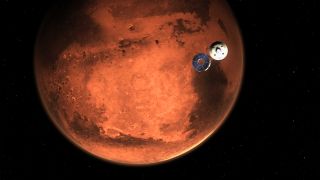
The aeroshell separates from the cruise stage about 10 minutes before Mars 2020 enters Mars' atmosphere, as shown in this illustration. Then, the aeroshell, which contains the Perseverance rover and descent stage, travels to the Martian surface on its own.
Measuring nearly 15 feet (4.5 meters) in diameter, the aeroshell consists of two parts: the backshell and the heat shield, which protects the spacecraft from burning up in the extreme heat generated during the initial descent through the planet’s atmosphere. The aerodynamics of the heat shield also serve as a "brake" to help slow the spacecraft.
Entering the Martian atmosphere

The EDL phase begins when the spacecraft reaches the top of the Martian atmosphere, at which point it is travelling nearly 12,100 mph (19,500 kph). Roughly 90 seconds after atmospheric entry, peak deceleration occurs, during which the spacecraft slows to under 1,000 mph (1,600 km/h).
During its descent to the surface, the spacecraft slows down using the drag generated by its motion in the Martian atmosphere. The aeroshell also fires small thrusters on the backshell to reorient itself and make sure the heat shield is facing the Red Planet as it plunges into the atmosphere.
This artist's concept depicts the initial stages of the spacecraft’s descent to Mars.
Seven minutes of terror
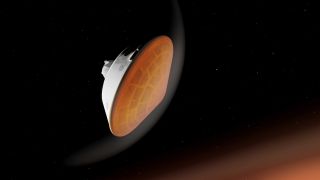
EDL will last approximately seven minutes. Once the EDL phase begins, the spacecraft uses a technique called guided entry. It takes about 14 minutes or so for radio signals to travel from the spacecraft to Earth, meaning the spacecraft will land on Mars without any help or intervention from NASA ground teams — which is why the spacecraft’s landing has been referred to as "seven minutes of terror."
The spacecraft's heat shield, which faces toward the planet, will endure peak heating of 2,370 degrees Fahrenheit (about 1,300 degrees Celsius), 75 seconds after entering the atmosphere.
In this illustrated scene, the friction of Mars' atmosphere is slowing the spacecraft's descent and heating the heat shield.
Perseverance's parachute
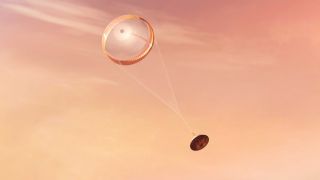
About four minutes after entering the Martian atmosphere, the spacecraft will deploy a supersonic parachute from its aeroshell, as shown in this illustration. Measuring 70.5 feet (21.5 m) in diameter, the parachute will deploy at an altitude of about 7 miles (11 km) and a velocity of about 940 mph (1,512 kph). The parachute will help slow the vehicle to about 200 mph (320 kph).
The parachute will be deployed using a new technology called Range Trigger, which will help Mars 2020 narrow in on the target landing area. NASA engineers have said that the Range Trigger technology can reduce the size of the landing ellipse — an oval-shaped area around the landing target — by more than 50%, meaning it will take Perseverance less time to get to its location of interest compared to previous missions that have landed on Mars. Range Trigger will autonomously adjust the timing of the parachute deployment based on the spacecraft’s position and distance from its landing target.
Perseverance inside the backshell
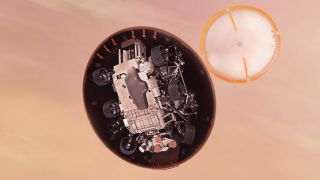
Next, the heat shield will separate and drop away from the backshell about 20 seconds after the parachute is deployed. The Perseverance rover and descent stage remain tucked inside the backshell of the spacecraft, as the parachute system continues to slow its descent to the Martian surface.
In this artist's concept, the rover is exposed to Mars’ atmosphere for the first time. In preparation for touchdown, the vehicle’s landing radar and Terrain-Relative Navigation system — a new autopilot technology — will begin assessing its altitude, position and velocity to help guide the rover to a safe landing on Mars.
The Terrain-Relative Navigation technology is new to Perseverance and includes a Lander Vision System, which uses a downward-facing camera to take images during descent, as well as an onboard computer to process the images and calculate the spacecraft’s approximate position relative to the ground on a finer scale than previous landing technology allowed. With this data, the new navigation system can adjust the rover’s touchdown point to avoid unsafe landing conditions.
The Range Trigger and Terrain-Relative Navigation technologies make landing on the floor of Jezero Crater possible, given the area’s challenging terrain, which includes steep cliffs, sand dunes, boulder fields and smaller impact craters.
Powered descent stage
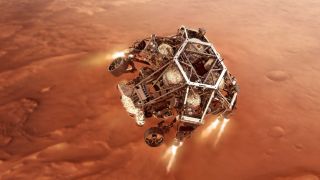
When the spacecraft reaches an altitude of 1.3 miles (2.1 km), the rover and descent stage will separate from the parachute and backshell. The descent stage is equipped with eight throttleable retrorockets, or Mars landing engines, which help slow the spacecraft in preparation for touchdown on the surface of Mars.
In this artist’s illustration, the descent stage fires up its engines during the final minute before Perseverance lands on the Red Planet. At this point in its descent, the spacecraft is traveling at about 190 mph (306 km/h). The landing engines will help guide the spacecraft to its landing target, level out and then slow the vehicle to its final descent speed of about 1.7 mph (2.7 km/h).
Touchdown!

At about 65 feet (20 m) from the ground — or about 12 seconds before touchdown — a sky crane will lower the rover safely to the surface. Three nylon cables extend 25 feet (7.6 m) below the descent stage to bring the rover to the ground. Meanwhile, the rover will stretch its legs and bring its wheels into landing position.
Once the rover senses that its wheels have touched the ground, it will cut the cables connecting it to the descent stage, which will then fly off and crash-land safely away from Perseverance. If all goes according to plan, the rover will begin its roughly two-year mission exploring Jezero Crater.
This illustrated scene shows the Perseverance rover landing safely on Mars, attached to the sky crane tethers.
The first interplanetary helicopter
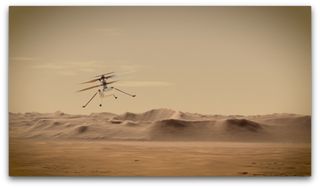
The Ingenuity Mars Helicopter, currently attached to Perseverance’s belly, will detach from the rover sometime between 30 and 90 days after the spacecraft touches down on the Red Planet. The helicopter will take a few pioneering test flights to prove that robotic flight is possible in the skies of another planet.
Step-by-step landing guide

This illustration captures a step-by-step view of the seven-minute entry, descent and landing plan for NASA’s Mars 2020 spacecraft.
Live coverage of the Perseverance landing will be available online from NASA Television and the agency’s website on Feb. 18 beginning at 2:15 p.m. EST (1915 GMT).
Follow Samantha Mathewson @Sam_Ashley13. Follow us on Twitter @Spacedotcom and on Facebook.
Join our Space Forums to keep talking space on the latest missions, night sky and more! And if you have a news tip, correction or comment, let us know at: community@space.com.

Samantha Mathewson joined Space.com as an intern in the summer of 2016. She received a B.A. in Journalism and Environmental Science at the University of New Haven, in Connecticut. Previously, her work has been published in Nature World News. When not writing or reading about science, Samantha enjoys traveling to new places and taking photos! You can follow her on Twitter @Sam_Ashley13.

